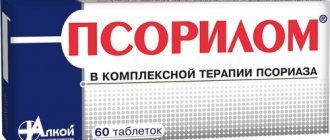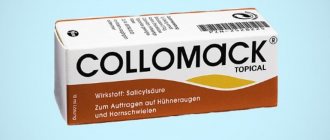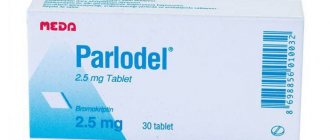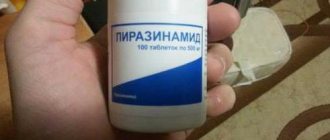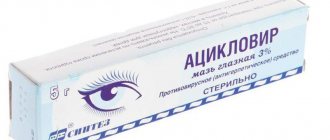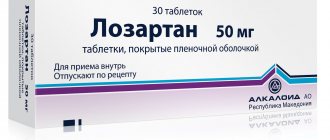Pharmacological properties of the drug Zyvox
Linezolid ((s)-N-[[3-[3-fluoro-4-(4-morpholinyl)phenyl]-2-oxo-5-oxazolidinyl]methyl]-acetamide) is a synthetic antimicrobial agent of the oxazolidinone group. Active in vitro against aerobic gram-positive bacteria, some gram-negative bacteria and anaerobic microorganisms. Linezolid selectively inhibits protein synthesis in bacteria: it binds to bacterial ribosomes and prevents the formation of a functional 70S initiation complex (an important component of the translation process). in vitro post-antibiotic effect of linezolid for Staphylococcus aureus was approximately 2 hours. In animal models, the in vivo was 3.6 and 3.9 hours for Staphylococcus aureus and Streptococcus pneumoniae , respectively. The following microorganisms are sensitive to linezolid: gram-positive aerobes - Corynebacterium jeikeium, Enterococcus faecalis (including glycopeptide-resistant strains), Enterococcus faecium (including glycopeptide-resistant strains), Enterococcus casseliflavus, Enterococcus gallinarum, Listeria monocytogenes, Staphylococcus aureus (including methicillin-resistant strains), Staphylococcus epidermidis, Staphylococcus ha emolyticus , Streptococcus agalactiae, Streptococcus intermedius, Streptococcus pneumoniae (including strains with moderate sensitivity to penicillin and penicillin-resistant strains); Streptococcus pyogenes, group streptococci , group C streptococci ; gram-negative aerobes - Pasteurella canis, Pasteurella multocida; gram-positive anaerobes - Clostridium perfringens, Peptostreptococcus anaerobius, Peptostreptococcus spp.; gram-negative anaerobes - Bacteroides fragilis, Prevotella spp.; others - Chlamydia pneumoniae. Moderately sensitive microorganisms: Legionella spp., Moraxella catarrhalis, Mycoplasma spp. Resistant microorganisms: Neisseria spp., Pseudomonas spp. The mechanism of action of linezolid differs from the mechanisms of action of other classes of antimicrobial drugs (for example, aminoglycosides, β-lactams, folic acid antagonists, glycopeptides, lincosamides, quinolones, rifamycins, streptogramins, tetracyclines and chloramphenicol). Therefore, there is no cross-resistance between linezolid and these drugs. Linezolid is active against pathogenic microorganisms, both sensitive and resistant to these drugs. Resistance to linezolid develops slowly through a multistep mutation of 23S ribosomal RNA and occurs with a frequency of less than 1 • 10 –9 –1 • 10 –11. Zyvox contains the biologically active (s)-linezolid, which is metabolized in the body to form inactive derivatives. The average pharmacokinetic parameters (standard deviation) of linezolid in healthy volunteers after single and repeated (until the steady-state concentration of linezolid in the blood is reached) oral administration are presented in the table. Pharmacokinetic parameters
Linezolid dosage regimen | Cmax, µg/ml (SD) | Cmin, µg/ml (SD) | Tmax,h (SD) | AUC*, µg•h/ml (SD) | t1/2, h (SD) | CL, ml/h (SD) |
| Once 600 mg | 12,70 (3,96) | — | 1,28 (0,66) | 91,40 (39,30) | 4,26 (1,65) | 127 (48) |
| 2 times a day 600 mg | 21,20 (5,78) | 6,15 (2,94) | 1,03 (0,62) | 138,00 (42,10) | 5,40 (2,06) | 80 (29) |
Cmax—maximum concentration in blood plasma; Cmin—minimum concentration in blood plasma; Tmax is the time to reach Cmax;
AUC*—area under the concentration/time curve; t1/2 - half-life; CL - system clearance; SD - standard deviation.
The average pharmacokinetic parameters (standard deviation) of linezolid in healthy volunteers after single and multiple (until the steady-state concentration of linezolid in the blood is reached) intravenous administration are presented in the table. Pharmacokinetic parameters
Linezolid dosage regimen (600 mg solution for infusion) | Cmax, µg/ml (SD) | Cmin, µg/ml (SD) | Tmax, h (SD) | AUC* µg•h/ml (SD) | t1/2, h (SD) | CL, ml/h (SD) |
| One time | 12,90 (1,60) | — | 0,50 (0,10) | 80,20 (33,30) | 4,40 (2,40) | 138 (39) |
| 2 times a day | 15,10 (2,52) | 3,68 (2,36) | 0,51 (0,03) | 89,70 (31,00) | 4,80 (1,70) | 123 (40) |
Suction. When administered orally, linezolid is rapidly absorbed from the gastrointestinal tract. The maximum concentration of the drug in the blood plasma is achieved after 2 hours, and the absolute bioavailability is about 100%. Distribution. Linezolid is rapidly distributed into well-perfused tissues. The volume of distribution of the drug upon reaching equilibrium concentration in a healthy adult averages 40–50 l, which is approximately equal to the total water content in the body. Binding to blood proteins reaches 31% and is independent of concentration. Metabolism. It has been established that cytochrome P450 isoforms do not participate in the metabolism of linezolid in vitro, and it does not inhibit the activity of clinically important CYP isoforms (1A2, 2C9, 2C19, 2D6, 2E1, 3A4). Metabolic oxidation of the morpholine ring primarily results in the formation of 2 inactive open-ring carboxylic acid derivatives. The metabolite hydroxyethylglycine (A) is the main metabolite in humans and is formed due to a non-enzymatic process. Another metabolite, aminoethoxyacetic acid (B), is formed in smaller quantities. Other “small” inactive metabolites have also been described. Excretion. Linezolid is primarily excreted in the urine as metabolite A (40%), unchanged drug C (30–35%), and metabolite B (10%). The unchanged drug is virtually undetectable in feces; 6% of metabolite A and 3% of metabolite B are excreted in feces. Pharmacokinetics in separate groups of patients. Linezolid clearance is higher in children and decreases with age. The pharmacokinetics of linezolid did not change significantly in patients aged 65 years and older. Some pharmacokinetic differences were noted in women, which were expressed in a slightly smaller volume of distribution, a decrease in clearance by approximately 20%, and sometimes in higher plasma concentrations. Since the half-life of linezolid does not differ significantly between women and men, there is no need for dose adjustment of the drug. In patients with moderate, moderate or severe renal insufficiency, no dose adjustment is required, since there is no relationship between creatinine clearance and renal excretion of the drug. Since 30% of the drug dose is eliminated by hemodialysis within 3 hours, linezolid should be administered to patients receiving such treatment after dialysis. The pharmacokinetics of linezolid do not change in patients with moderate or moderate hepatic impairment, and therefore there is no need to adjust the dose of the drug. The pharmacokinetics of linezolid have not been studied in patients with severe hepatic impairment, but since linezolid is metabolized by a non-enzymatic process, liver function should not have a significant effect on the metabolism of the drug.
Solution for infusion Zyvox
Average price 9500 rub.
1 milliliter of solution for infusion contains 2 mg of linezolid. Auxiliary components - sterile liquid for injection, sodium citrate and citric acid (in anhydrous form), glucose monohydrate.
The solution for infusion has a slight yellowish tint, transparent or completely colorless. The antibiotic is packaged in disposable bags of 100, 200 and 300 ml. Sachets are sold in cardboard boxes of 1, 2, 5, 10 or 25 pieces.
Directions for use and doses
The solution for preparing the infusion is placed into the cubital vein through a catheter. The substance is administered slowly over 0.5-2 hours. Typically, an intravenous solution is indicated for the treatment of severe clinical conditions and is used for a short period of time. After its use, the patient switches to tablets or suspension to undergo a full course of antibiotic therapy.
Use of the drug Zyvox
It is prescribed orally 2 times a day. Recommended doses for adults and adolescents (12 years and older):
Indications | Dose and route of administration | Recommended duration of treatment, days |
| Hospital-acquired pneumonia (including with bacteremia) | Orally or IV 600 mg every 12 hours | 10–14 |
| Enterococcal infections (including vancomycin-resistant strains and forms accompanied by bacteremia) | ||
| Orally or IV 600 mg every 12 hours | 14–28 |
Recommended doses for children (up to 11 years inclusive)*:
Indications | Dose and route of administration | Recommended duration of treatment, days |
| Nosocomial pneumonia (including with bacteremia) | Orally or IV 10 mg/kg every 8 hours | 10–14 |
| Enterococcal infections (including vancomycin-resistant strains and forms accompanied by bacteremia) | ||
| Orally or IV 10 mg/kg every 8 hours | 14–28 |
*Premature neonates <7 days of age (≤34 weeks of gestation) have lower systemic clearance of linezolid and greater AUC than full-term neonates and older infants. Preterm neonates older than 7 days have linezolid clearance and AUC rates similar to those of full-term and older infants.
The duration of treatment depends on the pathogen, the location and severity of the infection, as well as the clinical effect. The maximum dose for adults and children should not exceed 600 mg 2 times a day. IV is prescribed 2 times a day. The solution for infusion is administered over 30–120 minutes. IV infusion is carried out for 30–120 minutes. Do not connect infusion bags in series! It is necessary to remove the protective foil shell immediately before using the drug. The bag should be squeezed for approximately 1 minute to ensure that the integrity of the bag is not compromised. If the package leaks, the drug is unsterile and cannot be used! The remaining solution should be thrown into waste. Do not use partially filled containers! Elderly patients: no dose adjustment is required. Patients with renal failure: no dose adjustment is required. Patients with severe renal failure (creatinine clearance ≤30 ml/min): no dose adjustment is required. Due to the unknown clinical significance of high exposure (up to 10-fold) to the 2 primary metabolites of linezolid in patients with severe renal impairment, linezolid should be used with caution in such patients and only when the expected benefits of therapy outweigh the potential risks. Since approximately 30% of the administered dose of linezolid is eliminated during hemodialysis lasting 3 hours, linezolid must be administered after the hemodialysis procedure. A certain portion of the primary metabolites of linezolid are eliminated during hemodialysis, but the concentrations of these metabolites continue to be high after dialysis compared to those observed in patients with normal renal function or mild to moderate renal failure. Therefore, linezolid should be used with extreme caution in patients with severe renal impairment on dialysis and only if the expected therapeutic benefit outweighs the potential risk. There is no experience with the use of linezolid in patients who have been on peritoneal dialysis for a long time in an outpatient setting. Patients with hepatic impairment: No dose adjustment is required, however, due to limited clinical data, the use of linezolid in such patients is recommended only when the expected benefit outweighs the potential risk.
Indications for use
According to the instructions, Zyvox is used in the treatment of infectious and inflammatory diseases that are caused by anaerobic and aerobic gram-positive microorganisms sensitive to the drug:
- Skin and soft tissue infections;
- Enterococcal infections;
- Community-acquired pneumonia;
- Hospital pneumonia;
- Infections accompanied by bacteremia.
According to the instructions, Zyvox is also used for infections caused by gram-negative microorganisms, confirmed or suspected (as part of a combination treatment).
Side effects of the drug Zyvox
pain, abdominal cramps, flatulence, deviations in hematological parameters and liver function tests, diarrhea, headache, candidiasis, nausea, taste distortion, vomiting, transient anemia, thrombocytopenia, leukopenia and pancytopenia, candidiasis. Neuropathy (peripheral, optic nerve) has been observed rarely with linezolid use, especially when the maximum recommended treatment duration of 28 days is exceeded. During post-registration use of the drug, the following side effects were noted: from the blood system - reversible anemia, leukopenia, thrombocytopenia, pancytopenia; from the organ of vision - progression of optic neuropathy up to the development of blindness was sometimes reported (mainly observed when the maximum recommended duration of treatment of 28 days was exceeded); from the immune system - anaphylaxis; from the metabolic side - lactic acidosis; from the nervous system - peripheral neuropathy, seizures; from the skin and subcutaneous tissue - rash, angioedema, very rarely - Stevens-Johnson syndrome; from the gastrointestinal tract - changes in the color of the tongue, isolated cases of superficial changes in the color of teeth (plaque can be eliminated with professional dental cleaning).
Special instructions for the use of Zyvox
Pseudomembranous colitis of varying severity can develop with the use of almost all antibacterial drugs, including linezolid, and the severity can vary from moderate to life-threatening, which must be taken into account when diarrhea develops in a patient receiving antibiotic therapy. Cases of diarrhea associated with Clostridium difficile have been reported with the use of almost all antibacterial agents, including linezolid. The severity of diarrhea can range from moderate diarrhea to severe fatal colitis. Treatment with antibacterial agents alters the normal flora of the colon, leading to overgrowth of C. difficile . C. difficile produces toxins A and B, which cause diarrhea. strains of C. difficile cause increased morbidity and mortality because the infection they cause may be refractory to antimicrobial therapy and require colectomy. In all patients who develop diarrhea while on antibiotics, Clostridium difficile- . Some patients receiving linezolid may develop transient myelosuppression (anemia, thrombocytopenia, leukopenia and pancytopenia), depending on the duration of therapy. In this regard, it is necessary to monitor complete blood count indicators in patients who have an increased risk of bleeding and manifestations of myelosuppression, who are taking drugs that can reduce the amount of hemoglobin, platelets in the blood or impair their functional properties, as well as with a duration of treatment with linezolid of 2 weeks. Linezolid is inactive against gram-negative microorganisms and is ineffective in treating infections caused by them. If concomitant gram-negative infection is suspected or documented, therapy with drugs to which gram-negative bacteria are sensitive is recommended. Linezolid should be used with caution in patients with systemic infections at high risk of developing dangerous complications, such as infections due to the presence of a central venous catheter in patients in intensive care units. Linezolid is not indicated for use in patients with septic conditions due to catheter infection. Adequate and controlled studies of Zyvox in pregnant women have not been conducted. Zyvox should be used during pregnancy only for absolute indications, that is, when the potential benefit of drug therapy outweighs the potential risk. It is unknown whether linezolid passes into breast milk, so special caution should be exercised when using the drug during breastfeeding. No effect of the drug on the ability to drive vehicles or use other mechanisms was noted.
Precautionary measures
If during a course of treatment with Zyvox there is an increase in bowel movements and a change in the consistency of stool towards a more liquid one, then the patient should be carefully monitored so that he does not develop pseudomembranous colitis. Also, take the antibiotic with caution for more than two weeks. Patients who are taking concurrent medications to lower hemoglobin and those who are prone to bleeding should be carefully monitored. It is prohibited to take alcohol-containing drinks during the entire duration of medication therapy.
If a patient notices that his vision has deteriorated while taking the drug, he should urgently contact an ophthalmologist. Also, all patients who took Zyvox should have their vision rechecked 3 months after the end of therapy. If the condition of your teeth has changed for the worse, you should go to the dentist for an examination. It is not recommended to drive during drug therapy, as it affects reactions. The antibiotic has no effect on the mental state.
Drug interactions Zyvox
Linezolid is a weak, reversible, non-selective MAO inhibitor and may cause a moderate increase in the pressor effects of pseudoephedrine hydrochloride and phenylpropanolamine hydrochloride in some patients. It is recommended to reduce the initial doses of adrenergic drugs such as dopamine (or its agonists) and subsequently titrate the dose. The pharmacokinetics of linezolid are not altered by coadministration of aztreonam and gentamicin. Zyvox solution for infusion is compatible with the following solutions: 5% dextrose solution, 0.9% sodium chloride solution, lactated Ringer's solution for injection. Additional components should not be added to linezolid solution for infusion. If linezolid is prescribed concomitantly with other drugs, each drug should be administered separately in accordance with the dosage regimen and route of administration. Zyvox in solution for infusion is chemically incompatible with the following drugs: amphotericin B, chlorpromazine hydrochloride, diazepam, pentamidine isothionate, phenytoin sodium, erythromycin lactobionate, trimethoprim/sulfamethoxazole. In addition, the solution is chemically incompatible with ceftriaxone sodium.
Granules for Zyvox suspension
Average price: 9500 rub.
5 ml of the finished suspension contains 100 mg of linezolid. Additional substances - sodium citrate and benzoate, citric acid, MCC, sodium salt, sucrose, silicon dioxide, aspartame, sodium chloride, sweeteners and flavorings.
Granules for the preparation of a solution for oral use are white or light yellow in color. After dilution, the resulting suspension has a color similar to the color of the granules. Packaged in dark brown glass bottles with a capacity of 150 ml. Inside there are 66 grams of granular antibiotic. The set includes a measuring spoon.
Directions for use and doses
If the child is under 12 years old, then the best dosage is 10 mg of active substance per kilogram of body weight. The optimal choice is a granular form from which a drinking suspension is prepared. You can take Zyvox from the age of five. The maximum permissible daily dosage of the drug is 1200 mg.
